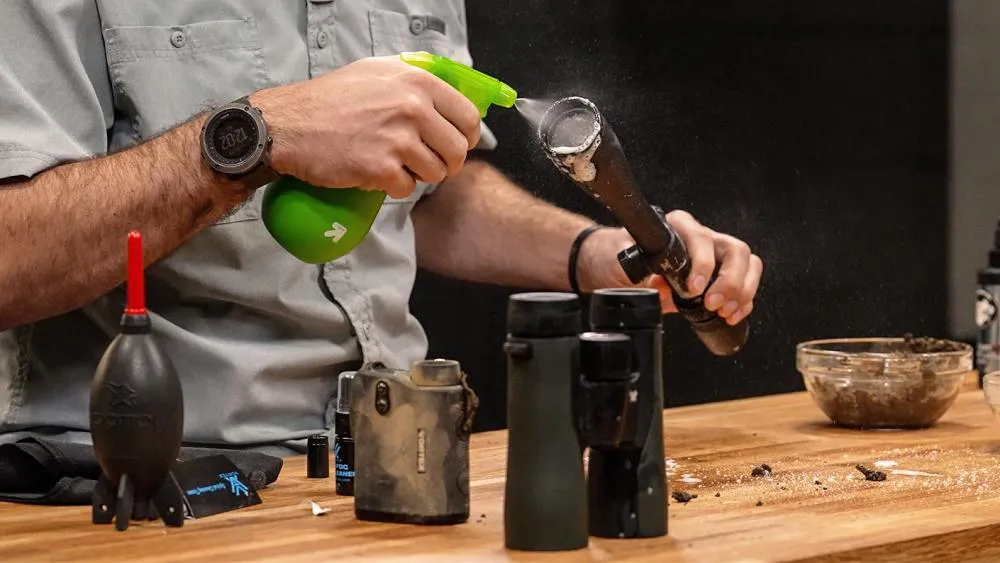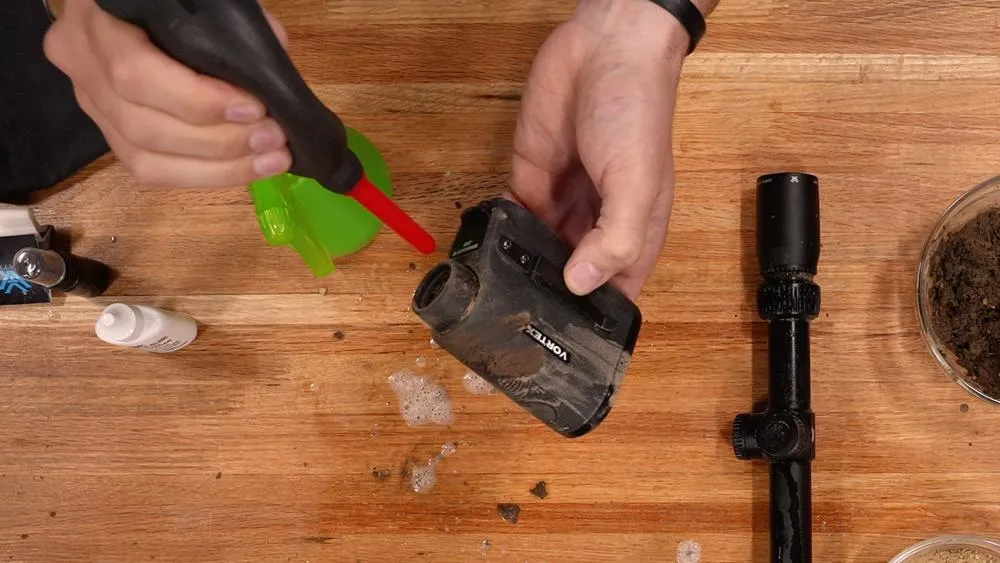Hunting, observing wildlife, or shooting at the range: Do it long enough, and your optics are bound to get dirty. But before you grab the hem of you T-shirt and start wiping away that dirt and those dried on water spots, you should know that maintaining your glass is simple, fast, and only takes a few pieces of gear.

Clean Your Optics The Right Way
Here’s how you can keep your optics clear and looking good.

Assemble your optics-cleaning kit
First, we need to make sure you have the right tools for the job. Here is a basic kit to have on hand:
- Warm, soapy water is a superhero for heavily soiled optics. If you have a spare spray bottle, that’s perfect. Not only will this work to help clean very soiled lenses, it will also be ideal for cleaning the outside of your optic. Dish soap is just fine.
- A lens pen with a soft bristle brush is an ideal way to gently remove loose debris from your lenses and external mechanical parts. Look for a pen that also has an optics-grade sponge on the other end for polishing.
- Optics-grade cleaning agents are formulated to not only clean your glass, but to not degrade optical coatings. (In a pinch, you can also use some pure rubbing alcohol.)
- Optical grade wipes and cloths are often the backbone of any cleaning kit, perfect for general maintenance and for polishing. For reference, your T-shirt is NOT an optics grade cloth…
- Air dusters are small rubber bulbs used to shoot pulses of air over your glass. Without touching your optic, they’re an excellent way to remove loose dirt and debris.
- Pretreated lens wipes are a “nice-to-have.” Already soaked in an optics grade cleaner, they make quick touch ups a snap.
Our Fog Free Field Kit is the perfect way to take many of these tools into the field.
How to properly clean binoculars
Try as you might to keep them clean, binos have a way of finding the mud and catching the sand. To keep your glass clear, follow these steps:
- Start by using your air duster to blow away any loose debris on your glass and exposed mechanical parts.
- Use your spray bottle of warm, soapy water to spray down your optic’s exterior. Since we’re not working on glass, a simple wipe down with a paper towel will usually do the job.
- To ensure there are no more particles on your lenses, use the soft bristles of your lens pen to gently clear away debris. As you do, slowly start working up your eye cups, removing any new exposed debris, alternating between your air duster and brush.
- Look at your lenses. Are they heavily soiled? Use soapy water to irrigate and gently clean, using cotton swabs if necessary. Are they lightly soiled, maybe with only a few dried water spots? Simply use a pretreated lens cloth.

No matter what type of optic, heavily soiled lenses are best treated by irrigating with soapy water.
How to properly clean riflescopes
One of the tricks with cleaning riflescopes is that you will sometimes be dealing with more foreign substances than other optics, namely gun oils and cleaners from maintaining firearms while the optic is still attached. These substances can reduce the hydrophobic properties of your lens coatings and lead to fogging issues in the field.
To clean soiled riflescope lenses, follow these steps:
- Start by using your air duster to blow away any loose debris on your glass and exposed mechanical parts.
- Spray your optic’s exterior with soapy water. Because you’re not touching your lenses yet, paper towel works just fine to wipe down the exterior parts of your scope.
- If you have gun oil or cleaners on your lenses, or they are otherwise heavily soiled, irrigate them with your soapy water. (If your lenses are mostly clear, simply use a pretreated wipe to get them sparkling clean.)
- Use the sponge end of your lens pen, or an optics-grade cloth, to lightly scrub and lift away the oil.
- Next, use an optics-rated wipe to remove the remaining moisture on your lenses.
- Finally, finish the cleaning with a pretreated wipe.
How to properly clean rangefinders
Dirty glass is bad in all optics, but with rangefinders, it can dramatically affect their performance. In addition to the lenses we’ve covered so far, rangefinders also have receiver and emitter lenses. These are where the laser leaves and returns to the rangefinder, and it’s critical to keep them clean. Here’s how to do it.
- Start by using your air duster to blow away any loose debris on your glass and exposed mechanical parts.
- Spray your optic’s exterior with soapy water. Because you’re not touching your lenses yet, paper towel works just fine to wipe down the exterior parts of your rangefinder.
- If your lenses, including the emitter lenses, are heavily soiled, irrigate them with soapy water. (If your lenses are mostly clear, simply use a pretreated wipe to get them sparkling clean.)
- Use the sponge end of your lens pen, or an optics-grade cloth, to loosen and lift away debris.
- Next, use an optics-rated wipe to lift away the remaining moisture on your lenses.

More so than other optics, soiling on a rangefinder’s lenses – especially its emitter and receiver lenses – can lead to poor performance.
Optics cleaning rules of thumb
With most optics, you can get the job done in much the same way. Here are three rules of thumb to follow as you put together an optics cleaning kit and use your new skills in the field.
- Start big, and work your way toward the smaller details. Obvious mud and other soiling needs to be dealt with first.
- Start on the outside and finish with the lenses.
- Take a cleaning kit into the field. From general maintenance to major clean ups, having the right tools means keeping your optics clear and scratch-free.
Contact Whylo For More Information
Copyright 2023 | All Rights Reserved | Powered by WILD & JAG / GAME & HUNT

